EMERGENCY PREPAREDNESS
A Guide to Emergency Preparedness for Latino Communities
What is Emergency Preparedness?
Emergency preparedness means getting ready for unexpected situations like natural disasters (floods, earthquakes, hurricanes) or other emergencies (power outages, fires, or health crises). It’s about having a plan, knowing what to do, and making sure you have the right supplies to keep yourself and your family safe.
Being prepared helps protect not just your health and safety but also your home and finances. Simple steps like making an emergency kit, knowing evacuation routes, and having a way to stay informed can make a big difference in staying safe before, during, and after a crisis.

For more resources on how to prepare, check out Ready.gov or FEMA.
High-Level Challenges:
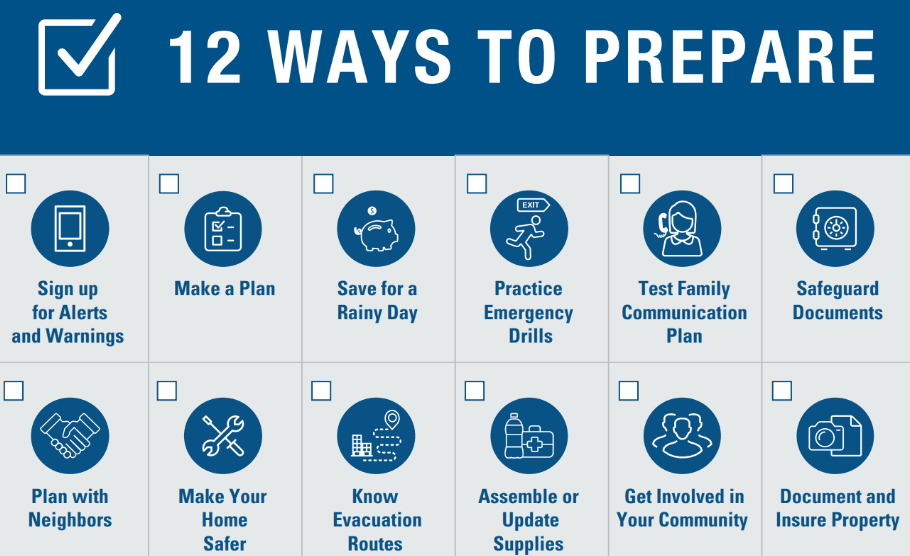
Cost: Those who are socioeconomically disadvantaged are less likely to be prepared for a disaster. FEMA.gov
Lack of Awareness: Many people are unaware of the risks in their area, the importance of preparedness, or how to prepare. FEMA.gov
Housing and Infrastructure Issues: Many Latinos live in older or less resilient housing, increasing their vulnerability. Poorly maintained infrastructure in predominantly Latino areas has historically heightened disaster impact. FEMA.gov
Language Barriers: Difficulty understanding English can hinder access to critical information during emergencies, including warnings, evacuation instructions and rescue efforts. Digital Commons
Key Statistics:
41% of those who are socioeconomically disadvantaged assembled or updated supplies whereas 50% of those who are not socioeconomically disadvantaged. FEMA.gov
Per capita income for individuals who are Hispanic is $28,026 compared to $50,675 for non-Hispanic Whites. Census.gov
People with awareness were 5x as likely to take at least 3 of the 12 preparedness actions than people without awareness. FEMA.gov
44% of those with less than a high school diploma believe that preparing can help in a disaster and were confident in their ability to prepare as opposed to 51% of those with a high school diploma or higher. FEMA.gov
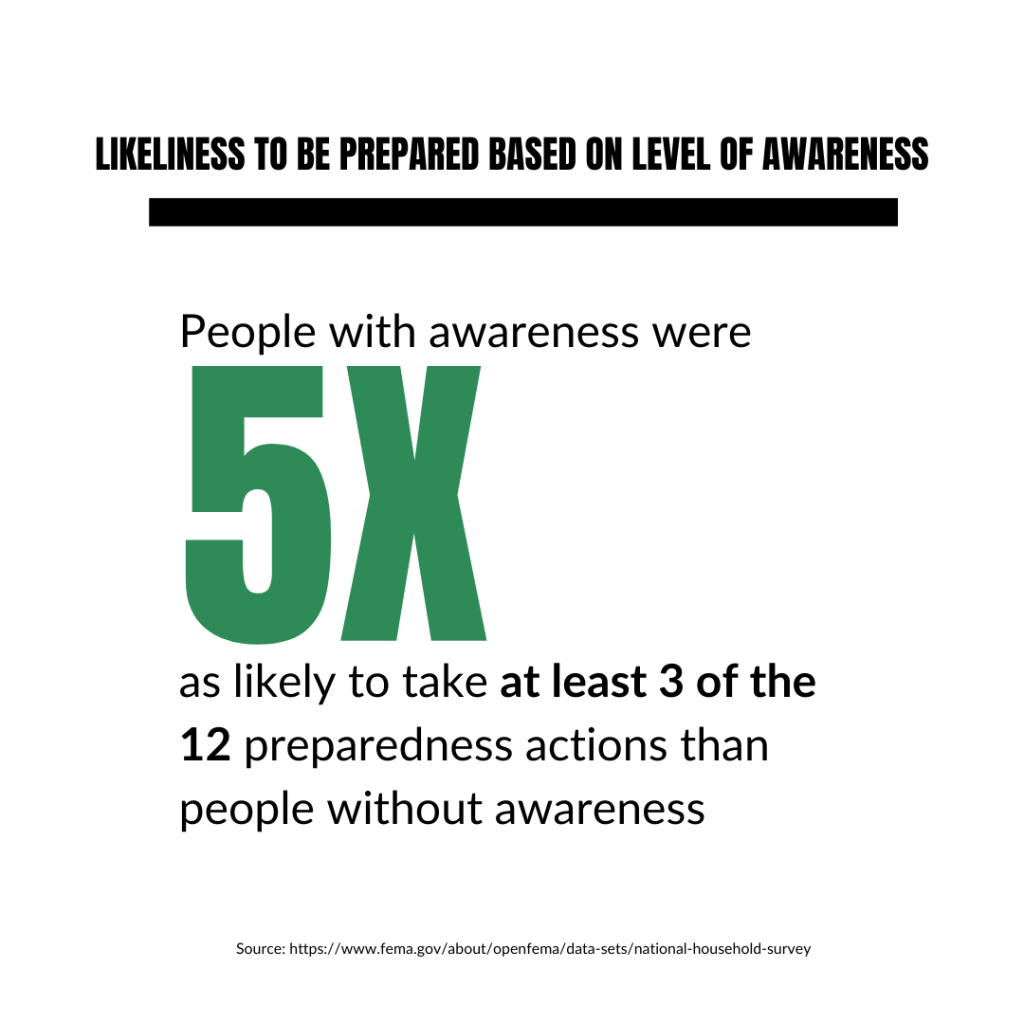
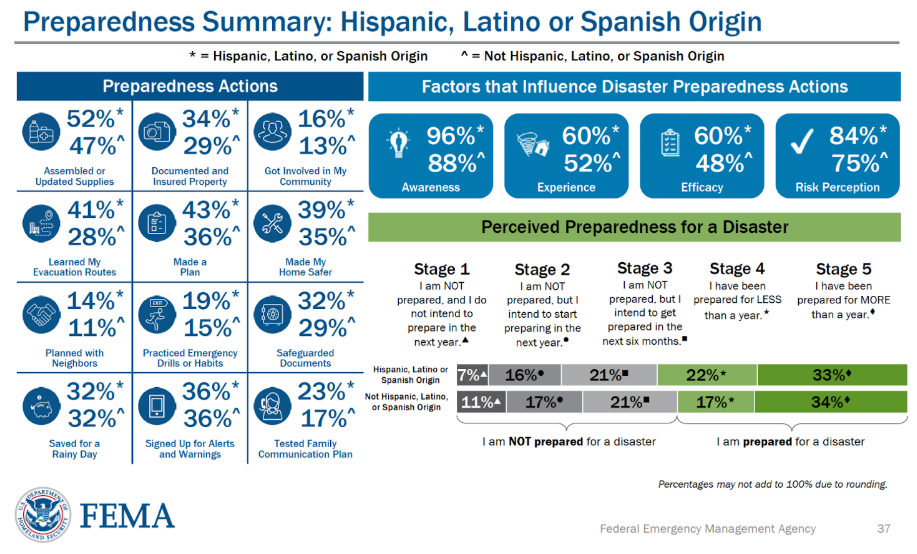
As of 2022, 26.6% of Hispanics had less than a high school diploma compared to 5.6% of non-Hispanic whites (link)
“Over 40% of Latino households are energy insecure – they cannot afford the energy required to heat and cool their homes… Households experiencing energy insecurity were also more likely to live in homes built before 1990.”
– Hispanic Access Foundation. (2023). Environmental policy toolkit: Impacts and Solutions for Latino communities. (link, page 28)
Why This Issue Is Important to Latinos
Emergency preparedness is critical for everyone, but especially so for Latino/Hispanic communities who often face compounded vulnerabilities. Language barriers, limited access to information, and cultural factors can further complicate response and recovery efforts. The following events can disrupt essential services, displace families, and exacerbate existing economic hardships.
COVID-19 & Influenza:
Latinos are 3 times as likely to get COVID-19 and twice as likely to die of it than the general population. Pubmed
In 2020, unemployment increased in America increased, disproportionately impacting certain groups with the highest impact being for Hispanic/Latina women at 6.2% unemployment rate (link – page 14)
“Latinos are disproportionately likely to be working in jobs and living in conditions that continue to expose them to the coronavirus… The virus that causes COVID-19 spreads more quickly in areas with more pollution, which are disproportionately inhabited by Latinos and other communities of color. Air pollution also causes the disease to be more severe. Studies have established a direct link between exposure to air pollution and COVID-19 morality… Because [Latinos] are more likely to live in polluted areas and spaces to get outdoors, people of color and low-income communities are more susceptible to developing immunocompromised illnesses such as asthma – a risk factor of COVID-19… Particularly in communities of color and low-income families have too few safe, close to home parks and coastlines where they are able to get outside. A lack of community green space is correlated with higher COVID-19 rates in communities of color… During a time of social distancing and increased safety of gathering outdoors when clean, fresh air is most wanted and needed, nature remained out of reach for too many, especially communities of color, low-income communities, and families with children ,” -Hispanic Access Foundation. (2023). Environmental policy toolkit: Impacts and Solutions for Latino communities – (link, page 42)
Seasonal Influenza Outbreak
The United States is currently experiencing one of its most severe flu seasons in 15 years, leading to significant health impacts: Axios
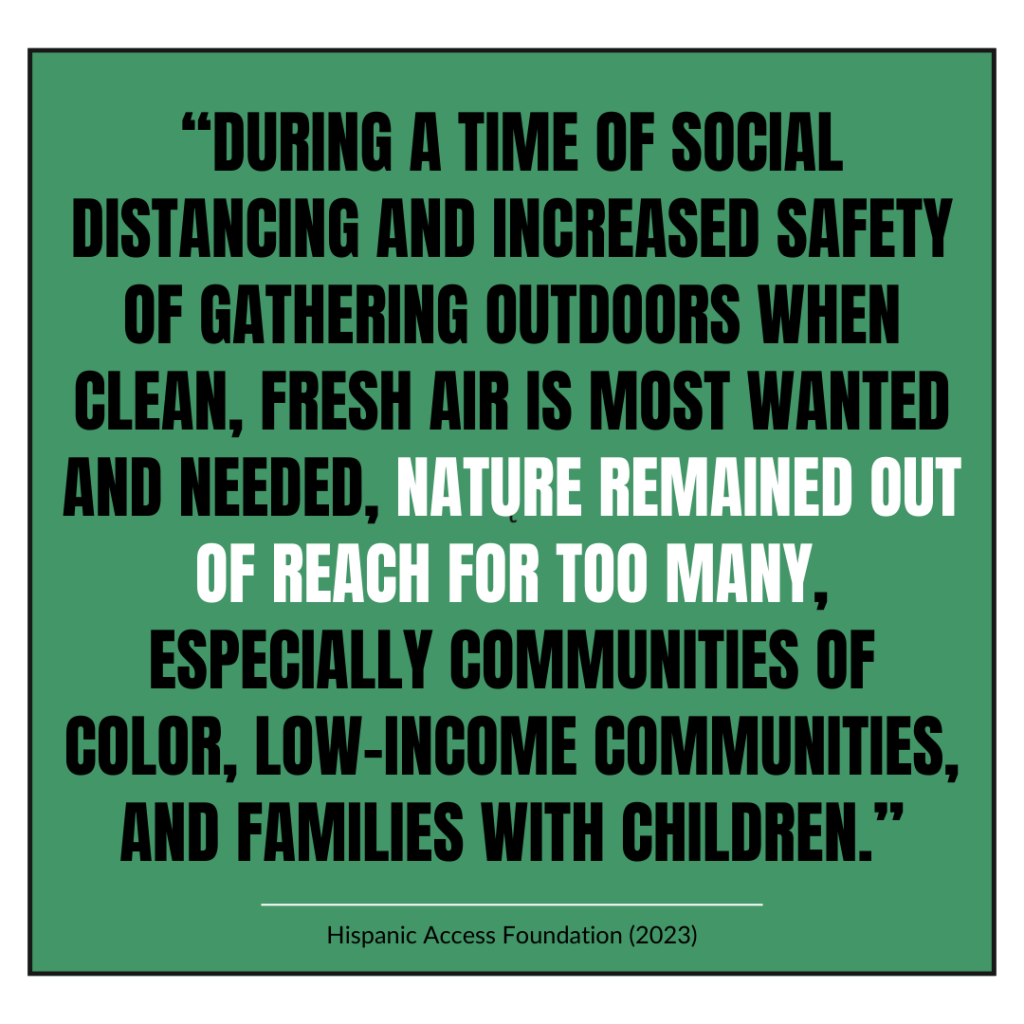
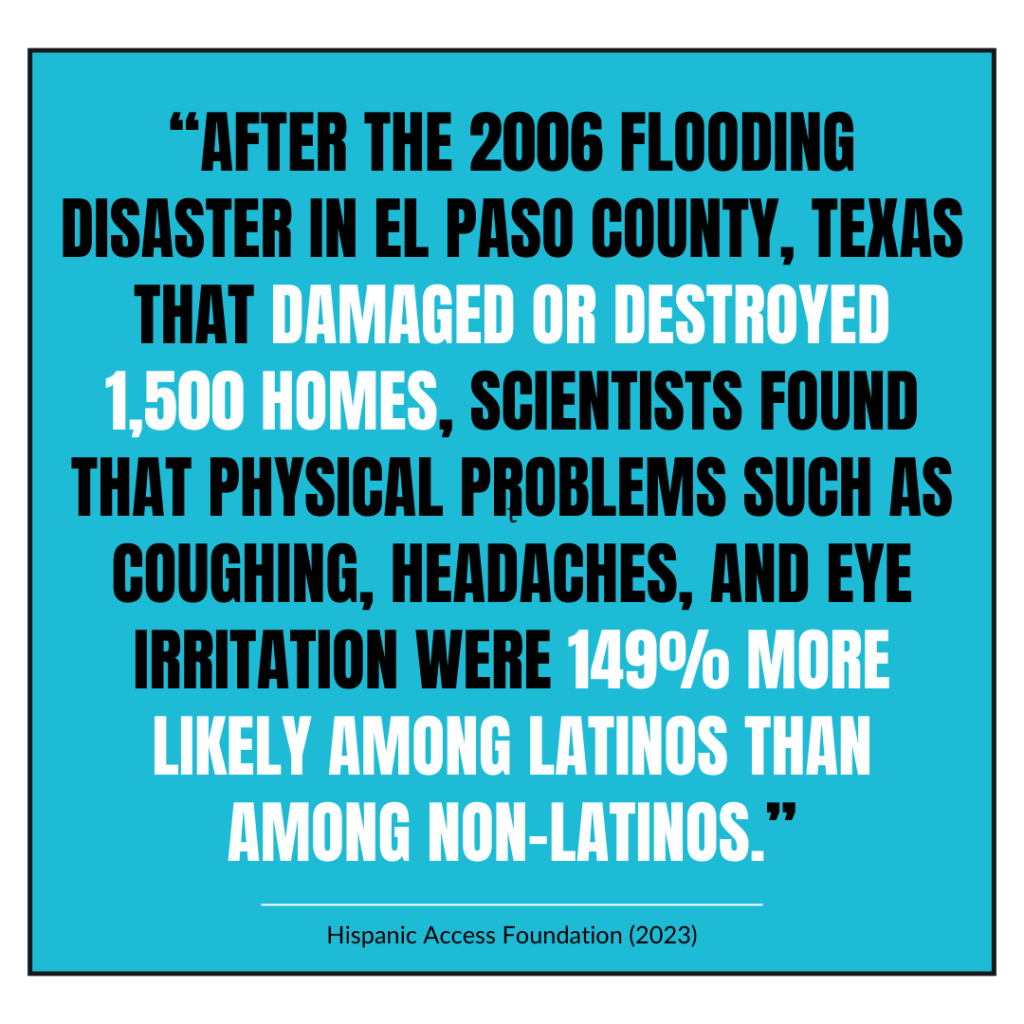
Hurricanes/Flooding
“After the 2006 flooding disaster in El Paso County, Texas that damaged or destroyed 1,500 homes, scientists found that physical problems such as coughing, headaches, and eye irritation were 149% more likely among Latinos than among non-Latinos… Many Latino communities are located in high-risk floodplains, and sea level rise is boosting the risk of coastal flooding… In Miami, for example, Black and Latino populations are more likely to live in areas exposed to inland flood risks… Because property values are an important factor in building adaptation measures like flood walls, low-income neighborhoods are less likely to be physically protected from stormwater and residents may be forced to evacuate more often,” Hispanic Access Foundation. (2023). Environmental policy toolkit: Impacts and Solutions for Latino communities – (link, page 31)
“At a national level, 44% of Latinos live in countries with high flood risks, in contrast with 35% of non-Latinos,”. Hispanic Access
A study found that Latinos in certain states were at higher risk for mortality, mental health, pregnancy complications, chronic diseases, acute gastrointestinal illness, and emergency department visits compared to their non-Latino counterparts. Pubmed
Hurricane Maria’s Impact on Puerto Rico
Hurricane Maria’s devastation in 2017 highlights the critical need for robust emergency preparedness:
- Widespread Destruction: The hurricane caused as much as $94.4 billion in damages, with about 80% of the island’s crop value wiped out, representing a $780 million loss in agricultural yields. Mercy Corps
- Mass Displacement: Approximately 130,000 Puerto Ricans left the island between July 2017 and July 2018, many as a direct result of Maria’s devastation. Mercy Corps
Wildfires
“In 2022, over 66,000 wildfires burned over 7.5 million acres. Latinos are twice as likely to be affected by wildfires than others in the U.S. Wildfire potential correlates with places with high Latino populations, in part because of the affordable housing crisis – homes are cheaper in wildfire-prone areas… Latinos have the highest uninsured rates in the U.S. – 52% of Latinos do not have private insurance coverage. This means Latinos are less likely to have access to healthcare services to prevent and treat health threats caused by wildfires and smoke. The poverty rate among Latinos in 2020 was 17% compared to the national poverty rate of 11.4%. This means that 1 in 6 Latinos do not have the economic resources to prepare, adapt, or cope with health issues associated with wildfires and poor air quality.” Hispanic Access Foundation. (2023). Environmental policy toolkit: Impacts and Solutions for Latino communities. Retrieved from Hispanic Access, page 25
California Wildfires
Recent wildfire seasons in California have disproportionately affected Latino communities:
- Increased Exposure: Latinos are twice as likely to be affected by wildfires compared to other populations in the U.S., partly due to the affordable housing crisis leading to more Latino families living in wildfire-prone areas.
- Healthcare Access Disparities: With 52% of Latinos lacking private insurance coverage, access to healthcare services to prevent and treat health threats caused by wildfires and smoke is limited.
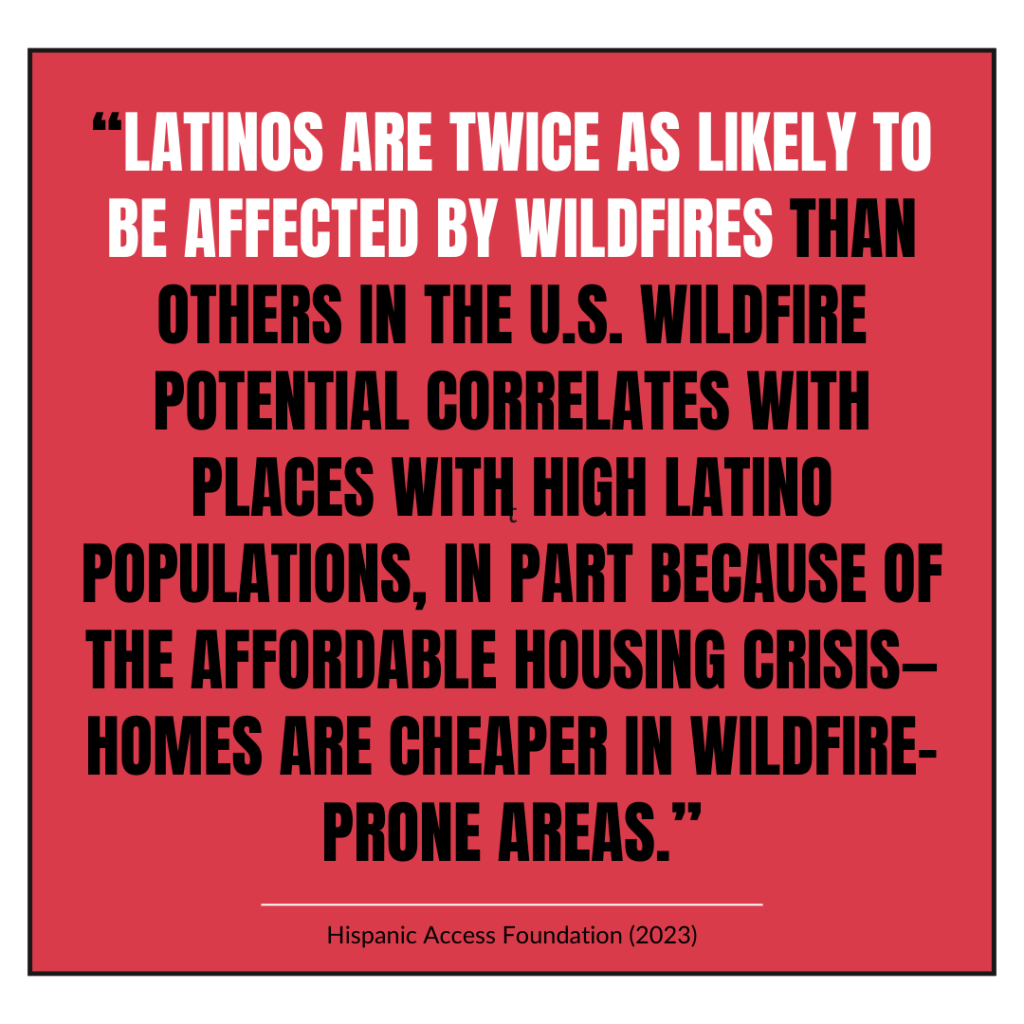

Here is a comprehensive list of emergencies that disproportionately impact Latino communities and require preparedness efforts, along with key evidence:
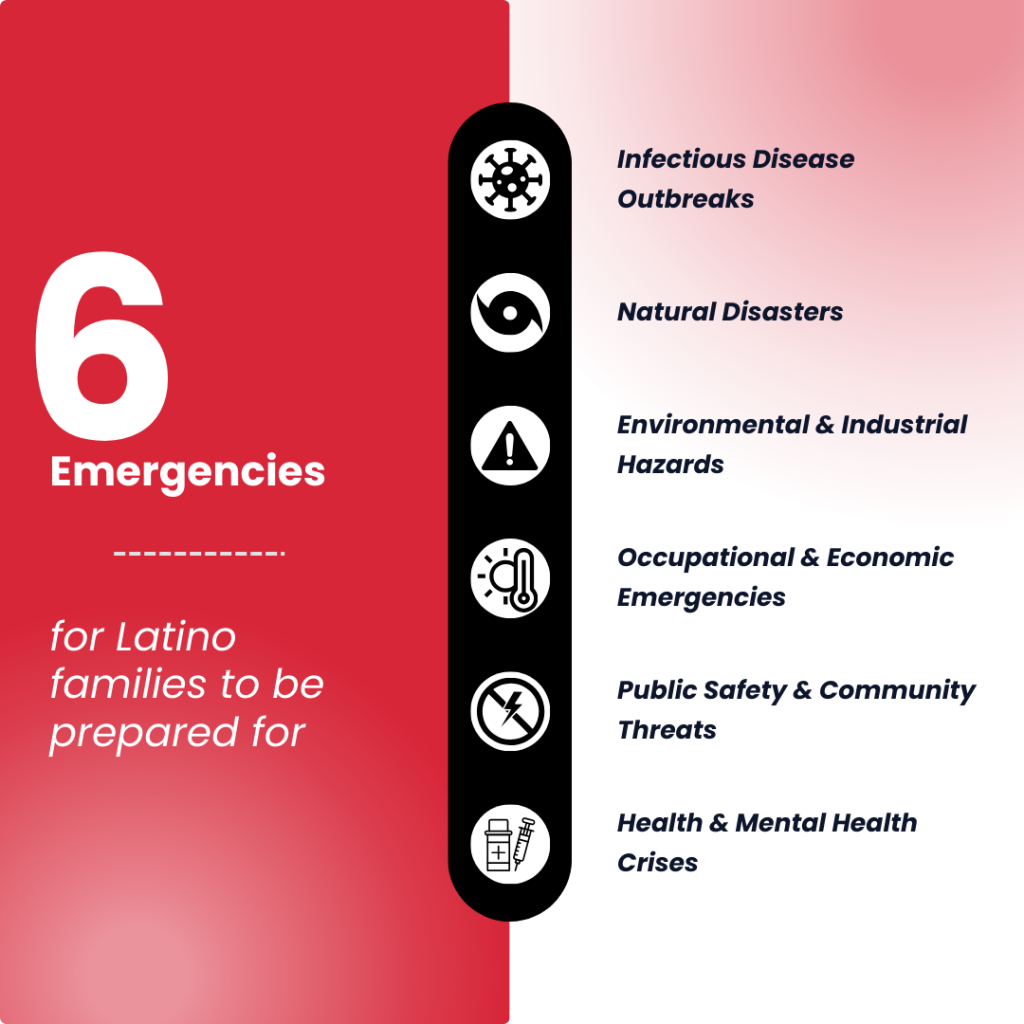
1. Infectious Disease Outbreaks
- COVID-19:
- Latinos experienced 2.8 times higher hospitalization rates and 2.3 times higher death rates than non-Hispanic whites due to systemic inequities and frontline work exposure. CDC
- Seasonal Influenza:
- Latinos have lower flu vaccination rates, making them more vulnerable to severe flu complications and hospitalization. CDC
- Tuberculosis (TB):
- Latinos represent 29% of all TB cases in the U.S. due to higher exposure risks in crowded or multigenerational housing. CDC
- Dengue & Mosquito-Borne Diseases:
- Dengue outbreaks have increased in Puerto Rico, Florida, and Texas, disproportionately affecting Latinos in these regions. WHO
2. Natural Disasters
- Hurricanes & Flooding:
- Hurricane Maria (2017) devastated Puerto Rico, causing nearly 3,000 deaths and leading to mass displacement. (Mercy Corps)
- Latinos in Texas, Florida, and Louisiana live in high-risk flood zones, with 44% of Latinos live in high-risk flood zones, often in poorly protected housing, with socioeconomic factors worsening their vulnerability. FEMA, Yale Climate Connections, Headwaters Economics, Hispanic Access
- Wildfires:
- Latino workers in agriculture and construction face high automation-related job losses while also being disproportionately impacted by wildfires due to hazardous job conditions, housing in fire-prone areas, and limited protective measures. Hispanic Access, UCLA Latino Policy Institute, Latino Policy, The Guardian
- Extreme Heat:
- Latinos are 21% more likely to live in urban “heat islands,” where lack of tree cover and green spaces increases exposure to deadly heat waves. EPA
3. Environmental & work Hazards
- Chemical Spills & Air Pollution:
- Latino communities near oil refineries and industrial plants are exposed to higher levels of air pollution, increasing respiratory illnesses like asthma and COPD. American Lung Association
- Water Contamination:
- Latino communities in California’s Central Valley and border regions often lack access to safe drinking water, increasing risk of diseases like E. coli and lead poisoning. NRDC

4. Occupational & Economic
Workplace Hazards:
- Latinos make up 65% of U.S. farmworkers, facing high exposure to pesticides, extreme heat, and hazardous conditions. EDF.org
Job & Income Loss:
- Latino workers face higher unemployment and fewer safety nets, with the unemployment rate for Hispanics increasing from 4.8% in February to a peak of 18.5% in April 2020, exceeding levels from the Great Recession. pewresearch.org, DOL.gov
5. Public Safety, Community ThreaTS
- Mass Displacement & Housing Crises:
- Latinos experience higher relocation rates due to climate disasters, leading to housing instability and economic stress. Brookings Institution
- Communities of color, including Latinos, face disproportionate climate hazards due to systemic disparities. Brookings Institution
- Low-income Latino households are at higher risk due to housing in flood-prone and disaster-prone areas. Brookings Institution
- Power Outages & Infrastructure Failures:
- Hurricanes and other natural disasters, are contributing to stress and trauma among affected populations in Texas. Texas Tribune
6. Health & Mental Health Crises
- Limited Healthcare Access:
- Mental Health Emergencies:
- Latino populations face higher stress and anxiety after disasters but are less likely to receive mental health support due to cost and stigma. (SAMHSA)

Why This Matters for Emergency Preparedness
Latino communities face multiple, overlapping risks, making emergency preparedness critical for survival, safety, and long-term resilience. Policies and strategies must be culturally relevant, linguistically accessible, and inclusive of the unique challenges Latino families face in disasters and crises.
Data: Key Statistics
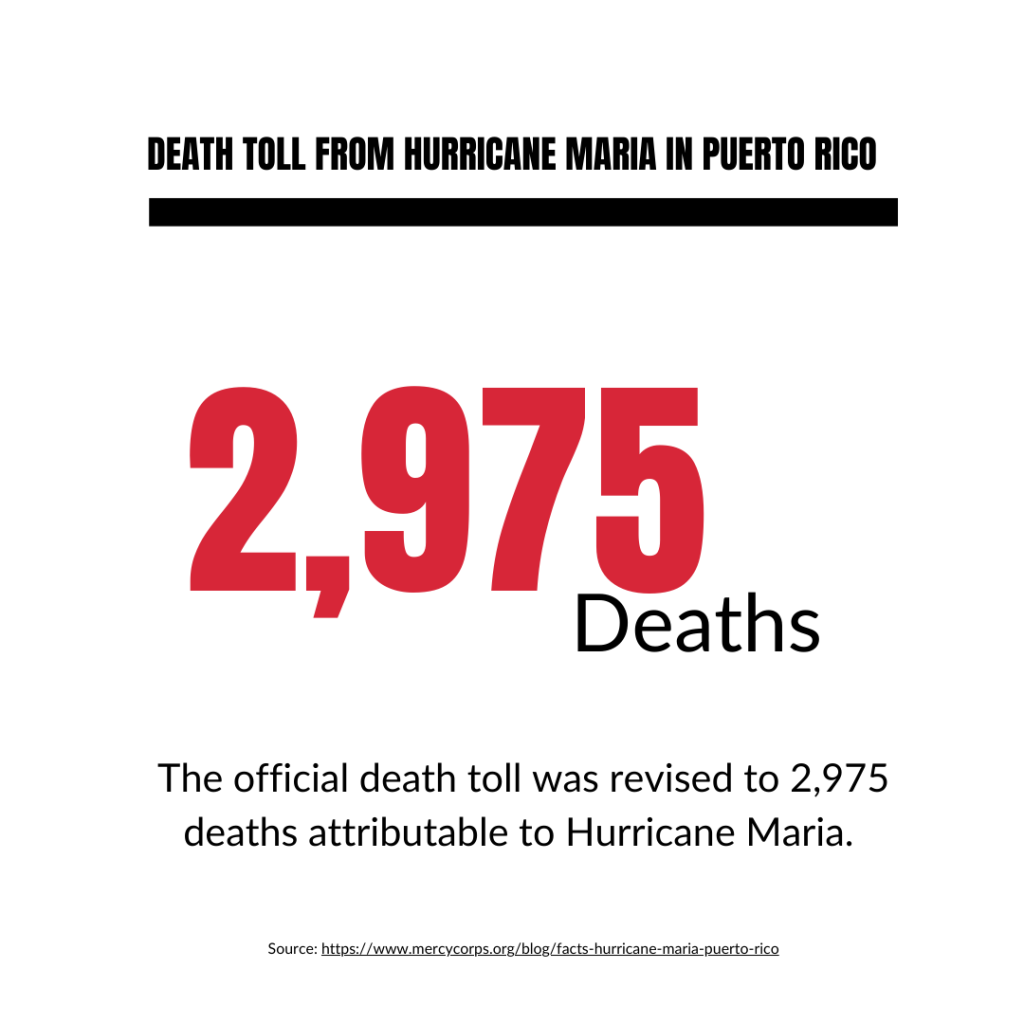
Between 2014 and 2017, opioid overdose deaths among Latinos increased by 170%, with fatalities from synthetic opioids like fentanyl rising by 617%. SAMHSA, Headlands
Hurricane Maria’s Impact on Puerto Rico (2017):
- The official death toll was revised to 2,975 deaths attributable to Hurricane Maria. PubMed Central
- Between July 2017 and July 2018, approximately 130,000 Puerto Ricans left the island, many as a direct result of Maria’s devastation. Mercy Corps
Population Decline in Puerto Rico Post-Hurricanes:
- The population of Puerto Rico stood at 3.2 million in 2018, its lowest point since 1979, representing a 3.9% decline from 2017, the largest year-to-year drop since 1950. pewresearch.org
Wildfires’ Impact on Latino Communities in Los Angeles County:
- At least 74,000 Latinos were at risk of displacement or were displaced due to recent wildfires, representing about 1 in 4 of those impacted. Latino Policy and Project
- Approximately 17% of residents in Latino neighborhoods are employed in outdoor occupations like construction, delivery, transportation, and agriculture, compared to just 6% in white neighborhoods, increasing their risk of respiratory illness and income loss during fires. UCLA Newsroom
Opioid Crisis Among Latino Populations:
- SAMHSA’s National Survey on Drug Use and Health estimates that 1.1 million Hispanic/Latino youth used illicit drugs in the past year, including 208,000 who misused opioids. SAMHSA
- Among Latinos, opioid-related death rates have almost doubled from 1999 to 2017, with particular increases in synthetic opioid-related deaths. PubMed Central
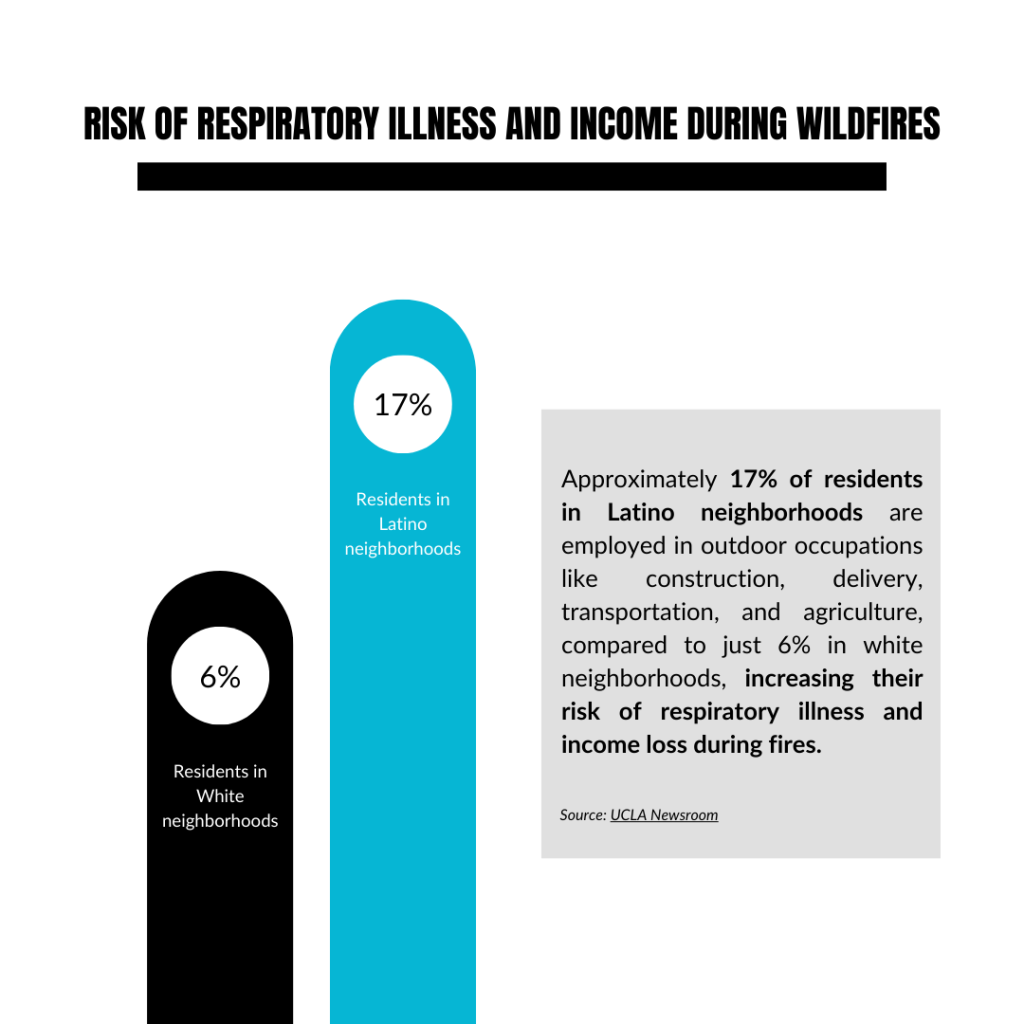
Programming, Policies & Recommendations
Current Policies
Note: These are existing policies we’ve compiled that are related to Emergency Preparedness.
- Federal Emergency Management Agency (FEMA) Programs FEMA + GAO.gov
- The National Preparedness Goal establishes a framework to prepare the nation for all types of hazards, emphasizing community-based approaches to resilience.
- Preparedness Grants – FEMA offers grants such as the Homeland Security Grant Program which funds state and local preparedness projects, and the Emergency Management Performance Grant which supports state and local emergency management programs.
- Ready Campaign – a public service campaign that promotes emergency preparedness through resources for individuals, families, and communities including materials in multiple languages.
- Strengths: Structured to be able to efficiently coordinate during large-scale disasters and mobilize resources quickly.
- Areas of Improvement: Understaffing, delays in aid distribution, issues with allocating resources, and trouble reaching underserved communities which need a faster disaster response.
- Stafford Disaster Relief & Emergency Act → Disaster Relief Act of 1974 Govinfo + Stafford Act + Disaster Philanthropy
- Authorizes federal disaster assistance for states and communities affected by emergencies and disasters. It includes provisions for pre-disaster hazard mitigation, encouraging communities to reduce risks before disasters strike.
- Strengths: Continued emphasis on hazard mitigation, technological innovation, and a stronger federal-state collaboration. Provides a clear framework for federal assistance.
- Areas of Improvement: Does not adequately address long-term recovery needs following a disaster.
- Authorizes federal disaster assistance for states and communities affected by emergencies and disasters. It includes provisions for pre-disaster hazard mitigation, encouraging communities to reduce risks before disasters strike.
- Community Development Block Grant – Disaster Recovery HUD.gov + HUD Exchange
- Administered by the Department of Housing and Urban Development, this program provides flexible funding for communities to recover from disasters and prepare for future risks. It often includes resources for underserved populations, including non-English speaking communities.
- Strengths: Flexibility in addressing a wide range of recovery needs from housing to infrastructure repair and its ability to target funding to the most affected communities. It allows for tailored recovery strategies based on local priorities.
- Areas of Improvement: Slow disbursement of funds, complex administrative processes which can delay recovery, and challenges in ensuring an equitable distribution of resources to all impacted groups, particularly underserved communities.
- Administered by the Department of Housing and Urban Development, this program provides flexible funding for communities to recover from disasters and prepare for future risks. It often includes resources for underserved populations, including non-English speaking communities.
- Pandemic and All-Hazards Preparedness and Advancing Innovation Act Congress.gov + CRS Reports
- Supports health care readiness for disasters, emphasizing collaboration between public health and emergency management.
- Strengths: Focus on enhancing the nation’s ability to respond to both pandemics and other public health emergencies. It supports innovation in medical countermeasures and provides support for at-risk populations.
- Areas of Improvement: Challenges in fully integrating new technologies and innovations into existing systems, gaps in equitable access to resources for vulnerable communities, and the complexity of being able to manage a broad range of threats (from pandemics to natural disasters) in a unified manner.
- Supports health care readiness for disasters, emphasizing collaboration between public health and emergency management.
Policy and Programmatic Recommendations
Data-driven solutions to further minimize infectious disease spread among U.S. Latinos.
Programmatic Recommendations:
- FEMA Individual and Community Preparedness: Activities has tabletop activities which includes discussion questions for the activity, a facilitator guide and some helpful links.
- Mapping Community Assets: Identify and map community assets, such as shelters, food banks, and medical facilities, to facilitate resource allocation during emergencies.
- Clinician Outreach and Communication Activity (COCA): provides timely, accurate, and credible information to clinicians related to emergency preparedness and response and emerging public health threats.
- Health Alert Network (HAN): provides urgent notifications about public health incidents and emerging health threats.
- Capture better data and report better data to best address needs of communities in routine and emergency surveillance.

Policy Recommendations:
Informed by Evidence: Policy Recommendations from Experts
- Recommendations by the Hispanic Access Foundation: “Protecting lands, waters, and oceans… Provide funds at every stage of the migration process… Laws and legislation for heritage… priority setting [especially in diverse and underserved areas],”. Hispanic Access Foundation, page 49
- The government should provide a stipend for households to purchase emergency toolkits or emergency toolkits to all households (similar to how COVID tests were handed out for free everywhere) in order to address the data which showed that there is a 9% difference of those who assemble or update their supplies based on socioeconomic status. FEMA
- Government needs to be more inclusive when planning for disasters and take into consideration diverse languages, housing, transportation situations, access to information technology, people who distrust the government, inform immigrants of their right to disaster aid, and other needs. FEMA
Call to Action: Get Involved
At the moment, there are challenges such as cost, lack of awareness, and housing issues that the Latino community faces when it comes to natural disasters and other unexpected emergencies. Emergency preparedness is important because it increases physical and financial safety in any crisis.
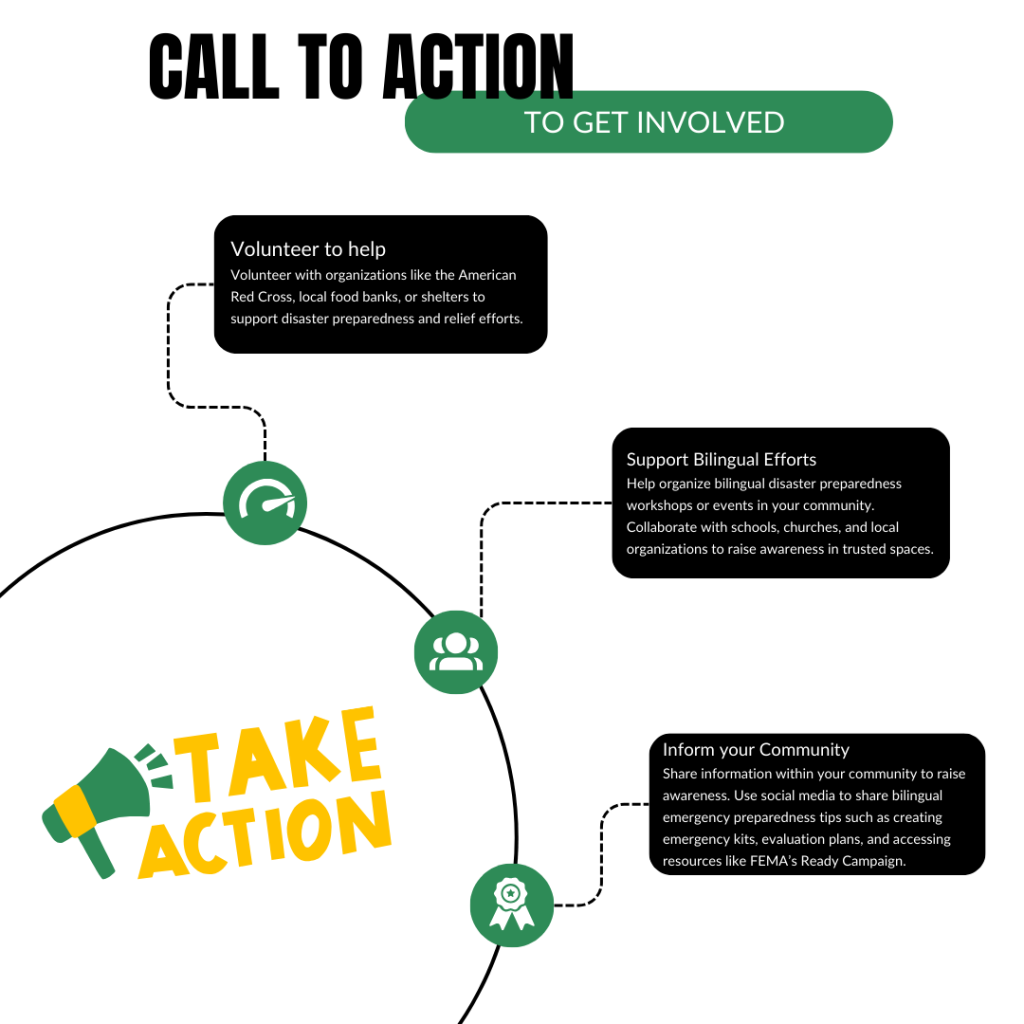
Volunteer with organizations like the American Red Cross, local food banks, or shelters to support disaster preparedness and relief efforts.
Help organize bilingual disaster preparedness workshops or events in your community. Collaborate with schools, churches, and local organizations to raise awareness in trusted spaces.
Share information within your community to raise awareness. Use social media to share bilingual emergency preparedness tips such as creating emergency kits, evaluation plans, and accessing resources like FEMA’s Ready Campaign (link)
Partners and Resources for Families
Core Partners
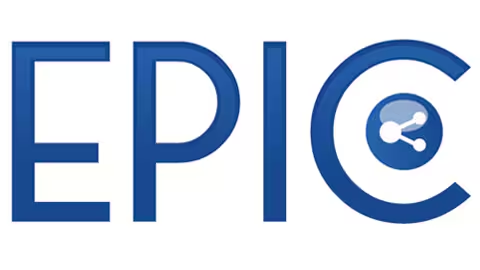
CDC Emergency Partners Information Connection (EPIC) | Website
EPIC provides science-based emergency preparedness and response information to public health professionals, organizations, and community leaders. Through webinars, training, and resources, EPIC ensures timely communication during crises, including disease outbreaks and natural disasters, helping Latino communities access life-saving information.
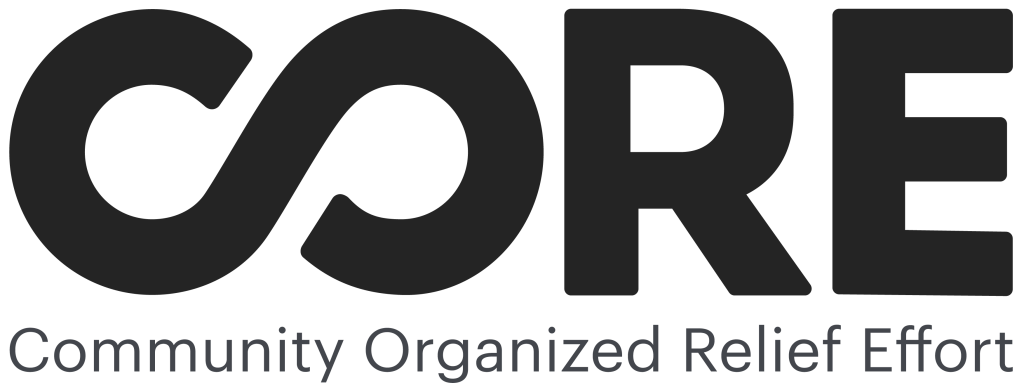
CORE (Community Organized Relief Effort) | Website
CORE delivers crisis response and long-term recovery services to vulnerable communities affected by disasters. From emergency aid to vaccine distribution, CORE prioritizes equitable disaster relief, ensuring underserved populations, including Latinos, receive critical support during and after emergencies.
🌍 Additional Resources for Families
Preparing your family for emergencies is crucial to ensure safety and resilience during unexpected situations.
Below is a curated list of family-specific resources, guides, and assistance programs to help you plan ahead and access support during emergencies:
Ready.gov – Family Emergency Planning
Description: Provides comprehensive guidelines to help families create tailored emergency plans, addressing communication strategies, evacuation routes, and essential supplies.
Website: https://www.ready.gov/plan
Emergency Response Plan: Click here.
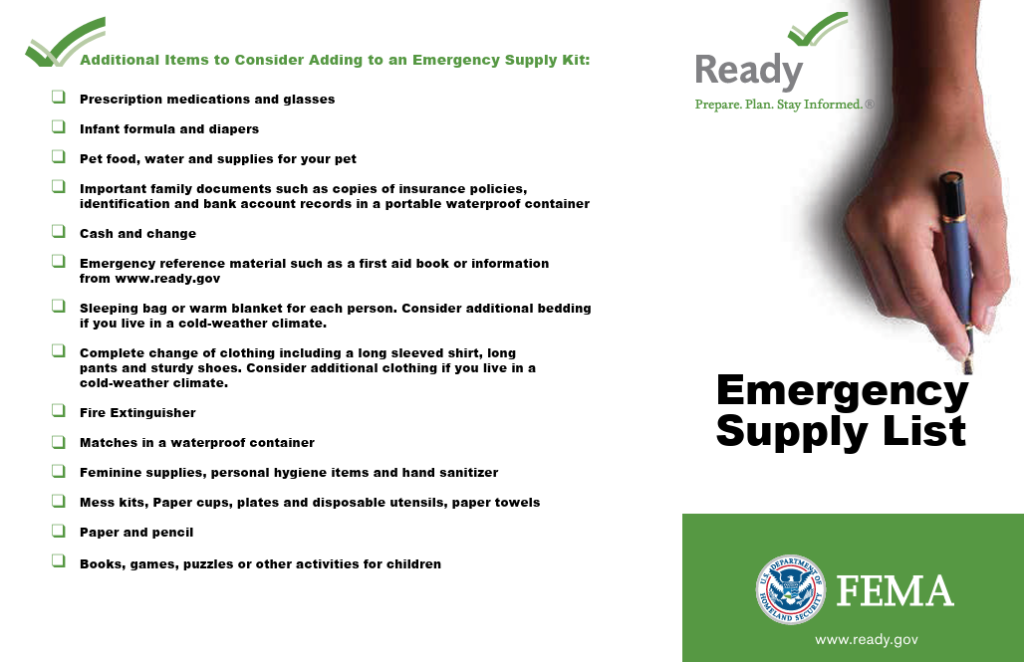
American Red Cross – Family Disaster Plan
Description: Offers tools and templates to assist families in developing customized disaster preparedness plans, including checklists and communication plans.
How to Prepare for Emergencies: Click here.
Build a Survival Kit: Click here.
Emergency Preparedness Tips for Common Emergencies: Click here.
Find your Local Red Cross: Click here.
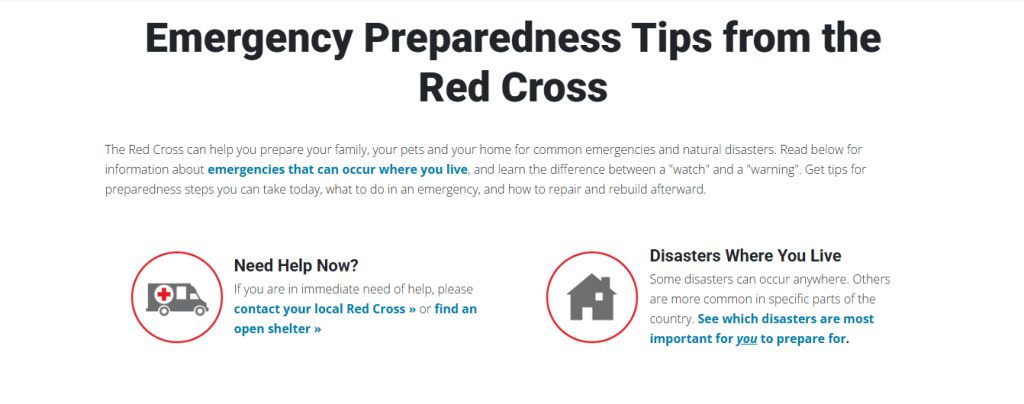
2-1-1 – Information and Referral Services
Description: A free, confidential service available 24/7 to connect individuals with local community services, including food, housing, and disaster assistance.
Website: https://www.211.org/
Find your Local 2-1-1: Click here.
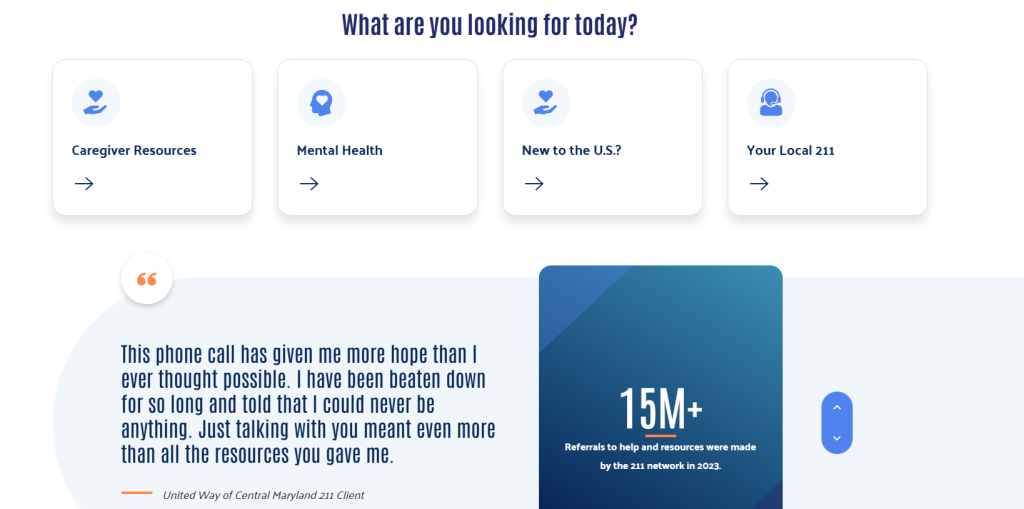
FEMA – Assistance Programs
Description: Provides financial assistance and direct services to eligible individuals and households affected by disasters, helping with housing and other necessary expenses.FEMA
Website: https://www.fema.gov/assistance/individual
Road to Recovery: Click here.
Programs to Support Survivors: Click here.
National Preparedness: Click here.
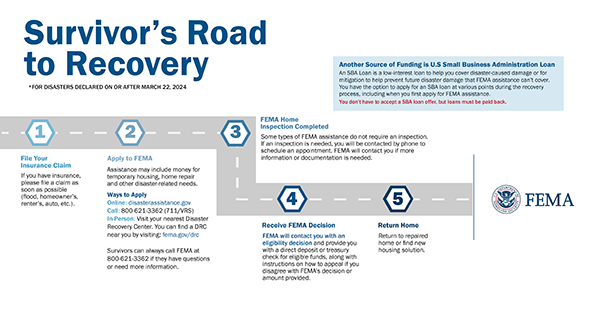
Additional Resources here:
- Loaves & Fishes RGV – Family Emergency Assistance
- Description: Offers short-term assistance with rent, utilities, and food to families in need, along with case management and follow-up services to ensure positive outcomes.lfrgv.org
- Website: https://lfrgv.org/how-we-help/family-emergency-assistance/
- Crossroads Foundation – Family Emergency Fund
- Description: Provides grants to families facing financial hardships, assisting with housing, utilities, food, transportation, and medical expenses.crossroadsfoundation.org+1USA.gov+1
- Website: https://crossroadsfoundation.org/pages/family-emergency-fund
- ADA National Network – Emergency Preparedness Resources
- Description: Offers resources to ensure that individuals with disabilities and their families are prepared for emergencies, including tailored preparedness plans and response strategies.
- Website: https://adata.org/emergency-preparedness
- Family Voices and AAP – Disaster Preparedness Resources for Families
- Description: Provides printable kits and flyers to help families follow key disaster planning steps, ensuring children’s needs are met during emergencies.
- Website: https://www.aap.org/en/patient-care/disasters-and-children/resources-for-families/
- Save the Children – Get Ready. Get Safe. Initiative
- Description: Focuses on safeguarding children during emergencies by providing resources for family preparedness, including creating emergency kits and reunification plans.
- Website: https://www.savethechildren.org/us/what-we-do/disaster-relief-in-america/preparedness
- Texas Health and Human Services – Cash Assistance (TANF)
- Description: The Texas Temporary Assistance for Needy Families (TANF) program offers cash payments to help families pay for food, clothing, housing, and other essentials during financial hardships.USA.gov+2hhs.texas.gov+2hhs.texas.gov+2
- Website: https://www.hhs.texas.gov/services/financial/cash/tanf-cash-help
Utilizing these resources can significantly enhance your family’s preparedness for emergencies, ensuring safety, well-being, and resilience in the face of unforeseen events.
🌍 Additional Resources and Data for Partners
Equipping partner organizations with the right resources is essential for enhancing community resilience and ensuring effective emergency preparedness. Below is a curated list of organizations and tools designed to support community-based entities in planning, training, and responding to various emergencies:
Resources and Data for Partners:
Latino-Focused Disaster & Climate Resilience Organizations
- Latino Community Foundation | Website
Supports Latino families impacted by wildfires through financial aid, rehousing assistance, and grassroots leadership development. - Hispanic Federation | Website
Strengthens disaster preparedness in Latino communities through collaboration with emergency response agencies and nonprofits. - Farmworker Justice | Website
Advocates for farmworkers’ rights, focusing on improving working conditions, health, and safety, including climate-related hazards.
National Emergency Preparedness & Response Organizations
- American Red Cross | Website
Provides disaster relief, emergency aid, blood donation services, and first aid training. - FEMA – Community Emergency Response Team (CERT) Program | Website
Trains volunteers in disaster response skills like fire safety, search and rescue, and medical operations. - Citizen Corps | Website
Engages local communities in emergency preparedness and response training.
Emergency Preparedness for Specific Populations
- ADA National Network – Emergency Preparedness Resources | Website
Provides resources to ensure emergency plans are inclusive of individuals with disabilities. - Administration for Community Living (ACL) – Emergency Preparedness | Website
Focuses on emergency planning for older adults and people with disabilities. - National Council on Aging (NCOA) – Emergency Preparedness for Community-Based Organizations | Website
Guides organizations in creating emergency action plans to protect older adults during disasters.
Disaster Preparedness & Training Organizations
- National Domestic Preparedness Consortium (NDPC) | Website
Provides training on emergency response, including chemical, biological, radiological, and natural disasters. - National Disaster Preparedness Training Center (NDPTC) | Website
Specializes in disaster preparedness training for coastal communities, islands, and underserved populations. - The American Civil Defense Association (TACDA) | Website
Offers training and publications on disaster preparedness and civil defense.
Community Recovery & Disaster Management
American Red Cross – Ready Rating Program | Website
A free program that helps organizations assess and improve their emergency preparedness.
DisasterAssistance.gov – Community Leaders Toolkit | Website
Helps communities manage long-term disaster recovery through planning and capacity building.
References
Click here to review all References:
American Red Cross. (n.d). American Red Cross. Retrieved from https://www.redcross.org/
American Red Cross. (n.d). Make a plan. Retrieved from https://www.redcross.org/get-help/how-to-prepare-for-emergencies/make-a-plan.html
Congress.gov. (n.d). S.1379 – A bill for reform of disaster recovery. Retrieved from https://www.congress.gov/bill/116th-congress/senate-bill/1379
Congressional Research Service (CRS). 2021. The Stafford Act and Its Role in Federal Disaster Assistance. Retrieved from https://crsreports.congress.gov/product/pdf/IF/IF12683
Disaster Philanthropy. 2022. The Stafford Act: Understanding the Key Role of Federal Assistance. Disaster Philanthropy. Retrieved from https://disasterphilanthropy.org/resources/the-stafford-act/
Federal Emergency Management Agency (FEMA). (n.d). About FEMA. Retrieved from https://www.fema.gov/about
Federal Emergency Management Agency (FEMA). (2018). Disaster Recovery Reform Act of 2018. Retrieved from https://www.fema.gov/disaster/disaster-recovery-reform-act-2018
FEMA Open Data. (n.d). National household survey datasets. Retrieved from https://www.fema.gov/about/openfema/data-sets/national-household-survey
FEMA. 2023. National Response Framework: Overview and Document. Federal Emergency Management Agency. Retrieved from https://www.fema.gov/sites/default/files/documents/fema_2023-npr.pdf
Federal Emergency Management Agency (FEMA). (n.d). Flood Insurance. Retrieved from https://www.fema.gov/flood-insurance
Farmworker Justice. (n.d). Climate Change. Retrieved from https://www.farmworkerjustice.org/climate-change/
Government Accountability Office (GAO). 2020. Disaster Recovery: FEMA’s Implementation of the Public Assistance Program. Retrieved from https://www.gao.gov/assets/830/820355.pdf
Government Publishing Office (GPO). (n.d). Compilation of disaster assistance laws. Retrieved from https://www.govinfo.gov/content/pkg/COMPS-2977/pdf/COMPS-2977.pdf
GSU University Library. (n.d). Emergency managers toolkit: Meeting the needs of Latino communities. Retrieved from https://opus.govst.edu/cgi/viewcontent.cgi?referer=https://www.google.com/&httpsredir=1&article=1067&context=iujsl
Hispanic Access Foundation. (2023). Environmental policy toolkit: Impacts and Solutions for Latino communities. Retrieved from https://hispanicaccess.org/news-resources/research-library/item/2346-2023-environmental-policy-toolkit-impacts-and-solutions-for-latino-communities
Hispanic Access Foundation. 2022. Latinos Face a Disproportionately Higher Risk of Flooding in the U.S. Here’s Why. Latin Times. Retrieved from https://www.hispanicaccess.org/news-resources/news-coverage/item/2872-latin-times-latinos-face-a-disproportionately-higher-risk-of-flooding-in-the-u-s-here-s-why
Hispanic Federation (n.d). About Hispanic Federation. Retrieved from https://www.hispanicfederation.org/about-hispanic-federation/
Latino Community Foundation (n.d). About us. Retrieved from https://latinocf.org/about-us/
League of United Latin American Citizens (LULAC). (n.d). About. Retrieved from https://lulac.org/about/
National Library of Medicine. (n.d). The Covid-19 Pandemic is straining families’ abilities to afford basic needs. Retrieved from https://pmc.ncbi.nlm.nih.gov/articles/PMC8841533/#bibr9-07334648211066920
Oppel, R.A., Gebeloff, R., Lai, K. K. R., Wright, W.,& Smith, M. (2020, July 5). The fullest look yet at the racial inequity of coronavirus. The New York Times. Retrieved from https://www.nytimes.com/interactive/2020/07/05/us/coronavirus-latinos-african-americans-cdc-data.htmlhttps://www.nytimes.com/interactive/2020/07/05/us/coronavirus-latinos-african-americans-cdc-data.html
Substance Abuse and Mental Health Services Administration (SAMHSA). (n.d). The intersection of low SES and disaster behavioral health. Retrieved from https://www.samhsa.gov/sites/default/files/dtac/srb-low-ses_2.pdf
Tidal Basin Group. 2022. Exploring the Stafford Act: History, Updates, and Impact on Emergency Management. Tidal Basin Group. Retrieved from https://www.tidalbasingroup.com/exploring-the-stafford-act-history-updates-and-impact-on-emergency-management/
The White House. (2021, January 20). Executive order on advancing racial equity and support for underserved communities through the federal government. Retrieved from https://www.whitehouse.gov/briefing-room/presidential-actions/2021/01/20/executive-order-advancing-racial-equity-and-support-for-underserved-communities-through-the-federal-government/
United Nations Office for Disaster Risk Reduction (UNDRR). (n.d). Global platform report 2024. Retrieved from https://www.undrr.org/media/79595/download?startDownload=20241104
United States Census Bureau. (2022). American Community Survey: United States demographics, 202.. Retrieved from https://data.census.gov/table/ACSSPP1Y2022.S0201?q=United%20States&t=400:451&g=010XX00US&y=2022
U.S. Department of Agriculture (USDA). (2015, August 5). Forest service report: Rising firefighting costs raise alarms. Retrieved from https://www.usda.gov/media/press-releases/2015/08/05/forest-service-report-rising-firefighting-costs-raises-alarms
U.S. Department of Housing and Urban Development (HUD). 2023. Community Development Block Grant – Disaster Recovery (CDBG-DR) Program Overview. HUD Exchange. Retrieved from https://www.hudexchange.info/programs/cdbg-dr/overview/
U.S Department of Housing and Urban Development (HUD). (n.d). CDBG-DR program offices. Retrieved from https://www.hud.gov/program_offices/comm_planning/cdbg-dr
Urban Institute. (2020). The COVID-19 pandemic is straining families’ abilities to afford basic needs. Retrieved from https://www.urban.org/sites/default/files/publication/102124/the-covid-19-pandemic-is-straining-families-abilities-to-afford-basic-needs_2.pdf
Vallurupalli, Sheela, et al. 2021. Flooding, Vulnerable Populations, and Public Health: A Critical Review. National Center for Biotechnology Information. Retrieved from https://pmc.ncbi.nlm.nih.gov/articles/PMC9363288/
